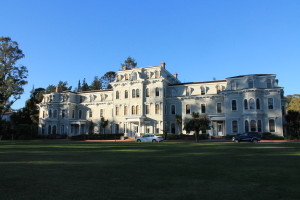
Sophomore Satania Gidney is one of two students who came to Mills College after learning Sweet Briar College, the all women’s college she previously attended, would be closing.
On March 3, Sweet Briar’s 530 students found out that their beloved school would be shutting its doors. Then a first year, Gidney, and her fellow students attended an assembly with no knowledge of what they were about to be told. The announcement they received devastated them.
“At first, none of us knew what was going on,” Gidney said. “We were all taking bets about what was [happening]. None of us thought this was going to happen.”
News first broke of Sweet Briar’s impending closure back in March of this year. The college’s board cited “insurmountable financial troubles” as the primary reason the school would be closing, according to the Washington Post. In addition, the Board said the school’s 84 million dollar endowment could not keep the school afloat while they struggled to attract new students.
According to Gidney, the announcement of the closure was made on the college’s website before the students were informed. Some professors were also forced to sign non-disclosure agreements the week prior to the announcement, saying they were not allowed to tell students about the news.
“My government professor asked me if I was planning to go [to the assembly],” Gidney said. “He looked me in the eye with the most serious expression I’d ever seen him have and said, ‘You need to go.’ That’s when I got nervous.”
Gidney said that many Sweet Briar students expressed concerns over whether or not the school would go co-ed. According to her, there were some students who felt this option was worse than closure.
“Sweet is sweet,” Gidney said. “It’s supposed to be the embodiment of strong femininity.”

After the announcement came, one of the first concerns for many Sweet Briar students was the fate of their faculty. Gidney said that much of Sweet Briar’s faculty lives on the campus grounds. The first question out of the mouths of students during the assembly was what would happen to their faculty.
“For a lot of us, our faculty was our family,” Gidney said. “It was…chaos.”
Kate Chavigny, an associate professor of history at Sweet Briar, lives on campus. When the news initially broke that Sweet Briar would close, Chavigny was in a position to lose her home.
“The prospect of losing my home on such a beautiful campus of a college where I had the privilege of teaching students who I came to know as human beings, was devastating,” Chavigny said in an email.
Teresa Tomlinson, Mayor of Columbus, Georgia and a Sweet Briar alumnae, said the school made her the woman she is today. She was disheartened by the original news of her alma mater’s closure.
“It was like a death in the family,” Tomlinson said in an email. “It also was just a huge waste. You had this great institution producing remarkable women leaders and the administration wanted to close it.”
After months of fighting against the closure and ultimately thinking the 2014 graduation would be the school’s last, Sweet Briar found out on Jun. 9 that they would remain open. According to the New York Times, the Virginia State Supreme Court blocked the closure of the college after the Supreme Court ruled colleges can be both trusts and corporations, and therefore the College’s board could not close the school without approval from a court.
Chavigny was thrilled to hear the school would remain open. She also believes the College’s new board and president, Philip Stone, appointed following the decision to keep the school open, are dedicated to Sweet Briar’s mission of educating women. She is optimistic about the College’s future.
“We were overjoyed, and we felt vindicated,” Chavigny said. “The closure decision was so wrong in so many ways! But by that time, we were also exhausted, and aware that we…had a tremendous amount of work ahead of us, and no roadmap to guide us.”
Sophomore Courtney Magnusson applied to several other schools after the initial announcement of Sweet Briar’s closure. When she and her friends were told the school would remain open, she was apprehensive about returning. After seeing how hard the new president and the other faculty were trying to get them to return, Magnusson chose to return.
“The feeling of pure joy was overwhelming,” Magnusson said in an email.
Gidney’s financial aid prevented her from waiting for the verdict of whether Sweet Briar would remain open or not. She chose Mills for the strong history, the theatre programs offered and the location of the school. Though she enjoys Mills immensely, she said she does miss the East Coast and Sweet Briar.
“Even now, I still refer to myself as a Vixen and as a Sweet,” Gidney said. “It’s a family there.”





